-
Immanuel (Part 1) Series
Contributed by Michael Stark on Dec 29, 2017 (message contributor)
Summary: A brief study of Isaiah's prophecy promising the birth of a child known as Immanuel.
Did you catch that? Not only did Ahaz begin to worship as the kings of Assyria worshipped, but he introduced those pagan rites to Israel—and Uriah the priest was complicit in all this. Ahaz introduced error into Israel’s worship, he desecrated the Temple and he led the priest to consent to this evil. I am not excusing the priest, but I am laying a major blame on the king. Things were going downhill when this prophecy was delivered.
Ahaz introduced structural changes to the Temple itself. These changes permitted him to conduct worship according to his own desires. Thus, we read, “King Ahaz cut off the frames of the stands and removed the basin from them, and he took down the sea from off the bronze oxen that were under it and put it on a stone pedestal. And the covered way for the Sabbath that had been built inside the house and the outer entrance for the king he caused to go around the house of the LORD, because of the king of Assyria” [2 KINGS 16:10-16]. As an aside of considerable significance: Admiring the godless can never result in honour to the Living God.
THE SOURCE — “The Lord himself will give you a sign” [ISAIAH 7:14a]. It is important to note the source of the prophecy. We know that all prophecy originates with the LORD God. This should be self-evident; however, it helps to point to the obvious so that no one passes over it. Thus, Isaiah begins this prophecy by emphasising that this is from God Himself. Refresh your memory of Peter’s testimony concerning what is written: “No prophecy of scripture ever comes about by the prophet’s own imagination, for no prophecy was ever borne of human impulse; rather, men carried along by the Holy Spirit spoke from God” [2 PETER 1:20, 21 NET BIBLE].
Perhaps Ahaz would not ask for a sign; however, a sign would be given—and that sign would come from God Himself. We are in the midst of the Advent Season. As we move ever closer to Christmas Day, we light the Advent candles and hear the Advent readings. Children realise that Christmas must be more—much more—than a day about fat men dressed in red suits, evergreen trees brought into the house and songs about horses dashing through the snow or magical snowmen. Hearing the Advent readings and seeing the Advent candles burning brightly suggests that Christmas is about Christ.
Our culture does try to masque this knowledge through a form of re-education as from earliest days we think about enriching ourselves through receiving gifts from others. We even encourage children to sit on the lap of strangers, telling them their most precious, secret longings. Then, when Christmas Day comes, children are told that a little fat man slid down the chimney to deliver the multiple gifts arrayed beneath the evergreen. That little fat man is omnipresent and omniscient—visiting every home throughout the entire world and knowing precisely whether the children are naughty or nice and gifting them on the basis of their character.
However, children who see the Advent candles and hear the Advent readings are alerted to the fact that Christmas has something to do with God Himself. He gave the message that delivered hope to a nation threatened. It was God who sent His Son to give His life as a sacrifice for sin so that no individual need ever stand condemned. When God is excluded from Christmas, there is really little reason for the season. The opening words of this brief verse that serves as our text today serves to remind us that Christmas is given by God. The hope to which we lay claim, the opportunity to reconnect with family and friends, the joy that floods over our lives are because God is at work in our lives—and He has been working for many years!

 Sermon Central
Sermon Central



